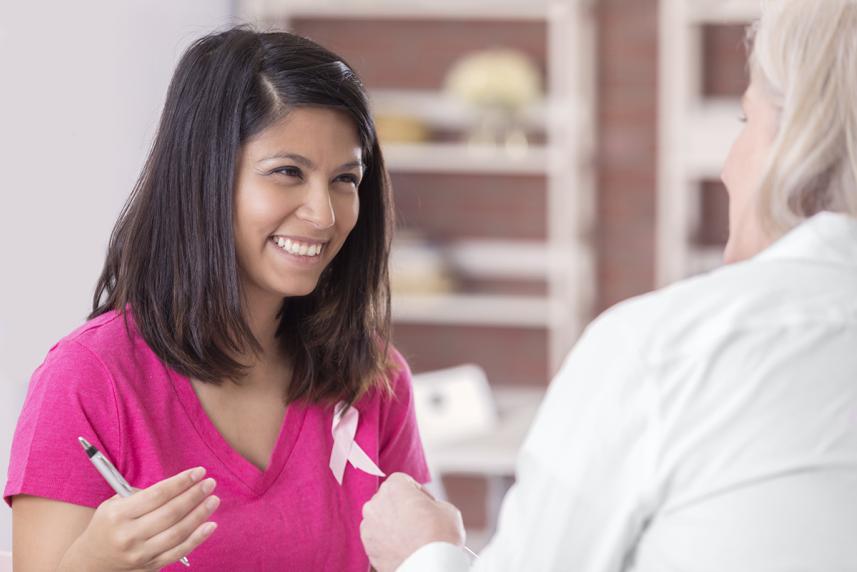
Get a free discount card from Optum Perks – accepted at pharmacies nationwide.

Early diagnosis can lead to successful treatment. Learn how to stay on top of your breast health at home and at the doctor’s office.
One in 8 women will have breast cancer in their lifetime.1 And 1 in 833 men will have it, too.11 Staying on top of breast screening is one of the best ways to find breast cancer at its earliest, most treatable stage. And today, the technology is advanced.
“Screening is our best weapon in the fight against breast cancer,” says Joseph Abrams, MD. He’s the chief of breast imaging at ProHEALTH, part of Optum, in Brooklyn and Long Island, New York. “Too many people wait until they feel symptoms.” And this may make cancer more difficult to care for.
Annual screenings can help doctors find breast cancer before there are symptoms. And that helps raise the chance of curing the disease. (Learn more about how to prevent cancer.)
The first step is simply to know your own breasts. Doing regular self-exams can make it easier for you notice a change.
Next, talk to your doctor about the right time to schedule your screenings. Mammograms, ultrasounds and MRIs are the main types of breast cancer screening done by medical professionals. The differences between them can be confusing. We're breaking down the basics of all three tests, including how each is performed and which might be best for you.
No two breasts are alike. Not even your left and right breasts are exactly the same. This is why it’s important to learn what’s normal for your body. You can do this through self-breast exams.
Here’s what you’ll want to look for:3
Regular self-exams are great for learning about your body. This is especially true if you’re not old enough to start routine mammograms. And once you do, keep up with self-checks. This will help you can spot any potential changes as soon as possible. Here's how to do one.
A mammogram is the most common type of breast cancer screening.4,5 It’s an X-ray that takes photos of breast tissue. Photos can help your doctor spot anything unusual such as:
There are two types of mammograms: screening and diagnostic.
A mammogram machine has two plates that press against the top and bottom of your breast. When the breast is flattened, the doctor can get a better view of the tissue.4
Women ages 40 to 44 with an average risk of breast cancer can choose to get a yearly mammogram. But if you wait, annual screening should start at age 45.6 If you’re at high risk for breast cancer or have certain breast tissue, your doctor may suggest a second type of screening. Or they may suggest starting earlier. Wondering if you’re at high risk? Learn more about genes and breast cancer.
Join the WISDOM study. This groundbreaking study is testing a personalized approach to breast cancer screening versus annual mammograms. It's easy to join and you complete most of it online. Learn more.
Ultrasound machines listen instead of look.7 They use sound waves and echoes inside the breast to create computer images. This screening is usually done after a mammogram.
Your doctor will put gel on your breast and then use a wand-shaped device to rub across your skin. Feel a little pressure? This is normal during an ultrasound.7
Breasts are made up of three types of tissues:8
“Ultrasounds in addition to mammography are recommended for women with dense breasts,” says Dr. Abrams. Having dense breasts means you have more glandular and fibrous tissue than fat. Glandular and fibrous tissues are harder to see through on a mammogram. They can easily block masses.8
Get health tips you can trust delivered straight to your inbox. Sign up for our health and wellness newsletter today.
MRI stands for magnetic resonance imaging. It’s used for women who have a higher risk of breast cancer. Your doctor can figure out your chance of getting breast cancer based on many factors. These include:
MRIs use magnets and radio waves to take photos of deep breast tissue.9 The pictures show more details than mammograms. And this helps the doctor look closely for anything unusual. Before the MRI, your doctor will inject blue dye into a vein.9 This dye gets into your tissues and blood vessels and makes them easier to see in pictures.
Women with a high risk for breast cancer should get an MRI every year. This screening may be done with a mammogram starting as early as age 30.6 You’re at high risk for breast cancer if:
MRIs, mammograms and breast ultrasounds show unusual changes in breast tissue. If your doctor finds something out of the ordinary, they may order a biopsy. A biopsy involves taking a sample of tissue from the body. The doctor will then test the tissue to see whether it’s cancerous. The hopeful news? Women with early-stage breast cancer have a 90% five-year survival rate.10
The bottom line? No one knows your breasts better than you. Keep up with self-exams and talk to your doctor about which screening is best for you. If you have insurance, routine mammograms must be covered. If you don’t have a health plan, here’s how to find affordable screening near you.

Get a free discount card from Optum Perks – accepted at pharmacies nationwide.
Sources
© 2024 Optum, Inc. All rights reserved. Do not reproduce, transmit or modify any information or content on this website in any form or by any means without the express written permission of Optum.
The information featured in this site is general in nature. The site provides health information designed to complement your personal health management. It does not provide medical advice or health services and is not meant to replace professional advice or imply coverage of specific clinical services or products. The inclusion of links to other websites does not imply any endorsement of the material on such websites.
Stock photo. Posed by model.